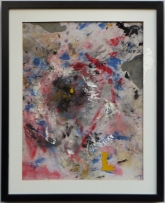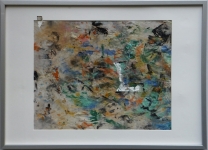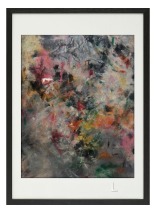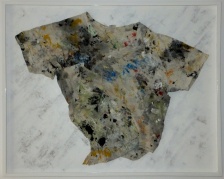 Art critic: “What is this B. S.? I don’t see anything new about it.”
Art critic: “What is this B. S.? I don’t see anything new about it.”
Artist: “Listen, if I’m not doing anything different, maybe it’s because I’m trying to do something fundamental.
Art critic: “What is this fun, duh, et mental?
Artist: “Look, there are certainly abuses in the blind quest of all these so-called important artists…I mean if they are forced to find something new in order to be considered important, then maybe that’s the only ‘force,’ or strength, of their work and that ain’t a good one, for their work must certainly look forced, while the forces I’m talking about are natural, naturally important too, for they are human, as human as they get. And they are opposing forces, with all the extra drama this entails, simultaneous, like two eyes, our eyes—one a witness to our sense of order, our order, the other to our sense of destruction, self destruction.”
Art investor: “Explain the value.”
Break to dialectic below (by T. L. MANN):
With the B. S. paintings (which I will refer to hereafter as the Bull Shit paintings) I tried to tame chaos, come to grips with it, to understand and neutralize it…I didn’t have much choice.
The Bull Shit paintings derive directly from the clean-up rags I had accumulated from doing the “Interface Paintings,” (first exhibited in the spring of 2013 in Paris, France). These paintings are not bull shit though because they derive from clean-up rags. The paintings are bull shit because of the profound philosophical meaning attached to them.
In order to understand, we must first begin with the Interface Paintings that the Bull Shit paintings derive from. The Interface Paintings are important for several reasons (multiple reasons—as opposed to our typical tendency to reduce everything to a simplistic explanation or even symbol—always being what is really necessary to express/explain any issue of human importance), however, one aspect in particular, and a major one at that, must be brought out here: the Interface Paintings demonstrated the immense importance that structure has in nature in general, and more importantly, in our nature.
And once we see this, we can better appreciate the core theme of the Bull Shit paintings—the theme being the total lack of structure that seems to be equally important as a force in nature, again, our nature.
As stated, structure for the Interface Paintings is primordial. It is celebrated as a human end and as an artistic revelation; refer to the T. L. MANN website for pictures and full explanations: https://day4thart.wordpress.com/. Coming up with the different elements that constitute the overall image of one of these paintings requires veritable ‘discoveries’ on the part of the artist, and this, for each and every element—an exemplary level of effort being truly necessary in order for them to all work together. This exceptional effort is necessary for a couple of reasons: Firstly, because the individual elements stand out, they are easily distinguishable, and because of this, they may easily be scrutinized, critiqued. The second reason necessitating this exceptional effort, these veritable discoveries, is due to the fact that the images that the elements make up are conceptual rather than representational—in effect, if they represented a ‘natural’ scene such as a landscape, the viewer would not question the ‘workability’ of the elements within the painting—because they would just be considered natural. Lastly, the paintings are not highly abstract either, wherein lack of structure is forgiven far more. Indeed, to make structure work, as witnessed in the Interface Paintings, a high degree of research, analysis, and calculation is required to come up with elements that are visually interesting and that work together towards a final image that is not only technically successful in terms of aesthetic rules but that is also satisfactory in respect to its theme, which at the outset, is the reason-to-be of the work, any work.
As fascinating as this structural type of work can be, however, I now turn to total disorder, another fundamental characteristic of our nature, and as such, another theme worthy of artistic expression. But being so fundamental, hasn’t this already been done? Hasn’t everything already been done for that matter? I mean, after all the abstract expressionism we have seen over the years—from canvases painted by a drip painting mind to those excreted by pigeon behinds—what could one possibly imagine left to be done in the way of disorder? On top of this I realized that this going from one extreme to the other, from total order to total chaos, may be interpreted as a lack of coherency in my oeuvre …fair enough…but—such interpretations are really no less errant than the mystical quest by so many artists for some ‘singularity’ whereby they want us to believe that they have discovered that “one thing.” That kind of stuff there is only ‘interesting’ in some esoteric, academically technical way for those heady individuals in the art milieu, or of course, for the art merchant who has to be able to claim—for marketing purposes—some sort of originality, which for the most part, unfortunately, is only forced, purely and simply contrived, non existent and/or deficient. Better to stick with the fundamentals: something human, something important to the bone—and see what comes of it.
Now to the heart of my Bull Shit art. It started from the natural allure of those clean-up rags. The colors and chaos I saw in all that paint were naturally…I will say attractive. But when I went to frame them, they didn’t seem finished. The frame, by virtue of what it implies and by the effect that it naturally has on its environment, required me to intervene. The natural implication of the frame is the following: what it frames is not a natural phenomenon and must not be taken as such, must not be ‘accepted’ as something in an otherwise seamless nature, where natural chaos is in natural flux with a certain degree of natural order. Indeed, the additional sense of order, the exceptional, ‘unnatural’ sense of order that the frame naturally possesses, its geometric ‘presence’, required me to add exceptional, ‘unnatural’ touches to the chaos in order for the final presentation to be correct, look natural, be satisfactory in the scheme of things at hand… Is it only a coincidence that this is precisely what the frame of an Interface Painting is all about?
Regardless, what it comes down to is this: I had to tame chaos. I had to fight the natural forces of entropy to maintain sufficient order. Now, is this sufficiently important as a subject for art? Is the imagery expressing it sufficiently interesting? I’ll let you yourself decide about these big words: fundamental, discoveries, singularities, or any other such pretense that has come up in this Bull Shit Painting treatise. But make no mistake about our nature, the complexity of our being (mind and body working together no less) and the complexity of the anatomical composition giving rise to all this. A literally incredible order has arisen between our countless atoms to constitute our seemingly miraculous self, too incredible perhaps for one to have much faith in. Indeed, and in effect, the very existence of this order gives rise, at the same time, to the underlying, simultaneous, ubiquitous, indisputable law of ‘entropy’—this natural physical force that acts upon us without exception—and that is irrefutably resolute in its task of tearing us down…to diddly squat.
Bull Shit art is my act of resistance.
![]() To download the book (format PDF) of the Exhibition and a complete explanation of the work: BS_Book_English BS Book_English
To download the book (format PDF) of the Exhibition and a complete explanation of the work: BS_Book_English BS Book_English
































